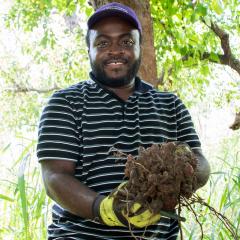A three-year pilot project led by The University of Queensland has shown installing shade structures in largely treeless paddocks could increase calf survival rates.

Led by Senior UQ Research Fellow Dr Kieren McCosker, the project evaluated the animal impact of feedlot-grade shelters installed close to water points in relatively treeless Mitchell grass-down country in the Barkly region.
“This region has high humidity, and temperatures above 40 degrees Celsius are not uncommon when cows are calving,” Dr McCosker said.
"The average calf loss in this environment is around 17 per cent, but it's also not uncommon for this to exceed 30 per cent for heifers.
“When an animal is hot, it loses its appetite, resulting in less energy, which we suspect reduces milk supply and maternal support, ultimately affecting production.”
The research team assessed the production benefits of shelters with a 75 per cent UV-block, installed at water points in a 56 square kilometre area.
Previous research like the Cash Cow project demonstrated the increased risk of calf loss during the calving period when high heat loads are experienced.
760 full-blood Wagyu heifers were monitored via GPS trackers, and weather stations were used to monitor conditions and determine a heat index.
“Our GPS data measured the distance each animal walked and the time spent under the shelter,” Dr McCosker said.
“We observed that all animals monitored sought shade at times, but the duration of shade-seeking varied between individual animals and environmental factors.
“Our analysis indicated that cattle could effectively dissipate accumulated heat loads by utilising shade for extended periods.
“This pilot study observed that mobs with access to shade had a 5.9 per cent higher calf survival rate, and more highly ranked shade-seeking individuals tended to have fewer calf loss events.”
Dr McCosker said while not statistically significant, the results from the pilot warrant further investigation.
“Given the high rate of average calf loss in northern Australia, an intervention that can reduce this by close to six per cent would have a large impact on production,” he said.
“We’re working with industry to see how we can investigate further, because a better industry understanding of calf loss will ensure continuous improvement in animal welfare, which is essential for maintaining consumer and community support for grass-fed beef.”
Dr Ian Braithwaite from the North Australia Beef Research Council said he believed the idea would work with smaller, less expensive shades aimed at calves.
“With the losses that we are seeing, a 5.9 per cent improvement in survival rate is a substantial result in terms of the welfare of our cattle,” Dr Braithwaite said.
“Producers would be willing to consider anything to reduce calf losses.”
The study was funded by Meat & Livestock Australia and completed in collaboration with the Northern Territory Department of Industry, Tourism and Trade and AACO.
The report can be accessed here.
Images and video are available via Dropbox.
Media contacts: UQ’s Dr Kieren McCosker, k.mccosker@uq.edu.au; +61 447 828 315; QAAFI Comms, Natalie MacGregor, n.macgregor@uq.edu.au, +61 409 135 651.
The Queensland Alliance for Agriculture and Food Innovation is a research institute at The University of Queensland established with and supported by the Department of Primary Industries.



